Assessing 40 Years of Flood Risk Evolution at the Micro-Scale Using an Innovative Modeling Approach: The Effects of Urbanization and Land Planning
Abstract
1. Introduction
2. Materials and Methods
2.1. Study Area and Available GIS Data
2.2. Tracking the Landscape Change in Time
2.3. Hydrodynamic Model for Hazard Assessment
2.4. A Model for the Within-Event Time-Evolution of Damage to Residential Buildings
2.5. Coupling of Hydrodynamic and Damage Models
3. Results
4. Discussion and Conclusions
Author Contributions
Funding
Data Availability Statement
Conflicts of Interest
References
- Arnell, N.W.; Gosling, S.N. The Impacts of Climate Change on River Flood Risk at the Global Scale. Clim. Chang. 2016, 134, 387–401. [Google Scholar] [CrossRef]
- Cea, L.; Costabile, P. Flood Risk in Urban Areas: Modelling, Management and Adaptation to Climate Change. A Review. Hydrology 2022, 9, 50. [Google Scholar] [CrossRef]
- Dottori, F.; Szewczyk, W.; Ciscar, J.-C.; Zhao, F.; Alfieri, L.; Hirabayashi, Y.; Bianchi, A.; Mongelli, I.; Frieler, K.; Betts, R.A.; et al. Increased Human and Economic Losses from River Flooding with Anthropogenic Warming. Nat. Clim. Chang. 2018, 8, 781–786. [Google Scholar] [CrossRef]
- Hallegatte, S.; Green, C.; Nicholls, R.J.; Corfee-Morlot, J. Future Flood Losses in Major Coastal Cities. Nat. Clim. Chang. 2013, 3, 802–806. [Google Scholar] [CrossRef]
- Hirabayashi, Y.; Mahendran, R.; Koirala, S.; Konoshima, L.; Yamazaki, D.; Watanabe, S.; Kim, H.; Kanae, S. Global Flood Risk under Climate Change. Nat. Clim. Chang. 2013, 3, 816–821. [Google Scholar] [CrossRef]
- Kundzewicz, Z.W.; Kanae, S.; Seneviratne, S.I.; Handmer, J.; Nicholls, N.; Peduzzi, P.; Mechler, R.; Bouwer, L.M.; Arnell, N.; Mach, K.; et al. Flood Risk and Climate Change: Global and Regional Perspectives. Hydrol. Sci. J. 2014, 59, 1–28. [Google Scholar] [CrossRef]
- Li, C.; Dash, J.; Asamoah, M.; Sheffield, J.; Dzodzomenyo, M.; Gebrechorkos, S.H.; Anghileri, D.; Wright, J. Increased Flooded Area and Exposure in the White Volta River Basin in Western Africa, Identified from Multi-Source Remote Sensing Data. Sci. Rep. 2022, 12, 3701. [Google Scholar] [CrossRef]
- Merz, B.; Hall, J.; Disse, M.; Schumann, A. Fluvial Flood Risk Management in a Changing World. Nat. Hazards Earth Syst. Sci. 2010, 10, 509–527. [Google Scholar] [CrossRef]
- Meyer, V.; Becker, N.; Markantonis, V.; Schwarze, R.; Van Den Bergh, J.C.J.M.; Bouwer, L.M.; Bubeck, P.; Ciavola, P.; Genovese, E.; Green, C.; et al. Review Article: Assessing the Costs of Natural Hazards-State of the Art and Knowledge Gaps. Nat. Hazards Earth Syst. Sci. 2013, 13, 1351–1373. [Google Scholar] [CrossRef]
- Miller, J.D.; Hutchins, M. The Impacts of Urbanisation and Climate Change on Urban Flooding and Urban Water Quality: A Review of the Evidence Concerning the United Kingdom. J. Hydrol. Reg. Stud. 2017, 12, 345–362. [Google Scholar] [CrossRef]
- Sampson, C.C.; Smith, A.M.; Bates, P.D.; Neal, J.C.; Alfieri, L.; Freer, J.E. A High-Resolution Global Flood Hazard Model. Water Resour. Res. 2015, 51, 7358–7381. [Google Scholar] [CrossRef]
- Sofia, G.; Roder, G.; Dalla Fontana, G.; Tarolli, P. Flood Dynamics in Urbanised Landscapes: 100 Years of Climate and Humans’ Interaction. Sci. Rep. 2017, 7, 40527. [Google Scholar] [CrossRef]
- Viero, D.P.; Roder, G.; Matticchio, B.; Defina, A.; Tarolli, P. Floods, Landscape Modifications and Population Dynamics in Anthropogenic Coastal Lowlands: The Polesine (Northern Italy) Case Study. Sci. Total Environ. 2019, 651, 1435–1450. [Google Scholar] [CrossRef]
- Winsemius, H.C.; Aerts, J.C.J.H.; van Beek, L.P.H.; Bierkens, M.F.P.; Bouwman, A.; Jongman, B.; Kwadijk, J.C.J.; Ligtvoet, W.; Lucas, P.L.; van Vuuren, D.P.; et al. Global Drivers of Future River Flood Risk. Nat. Clim. Chang. 2016, 6, 381–385. [Google Scholar] [CrossRef]
- Doberstein, B.; Fitzgibbons, J.; Mitchell, C. Protect, Accommodate, Retreat or Avoid (PARA): Canadian Community Options for Flood Disaster Risk Reduction and Flood Resilience. Nat. Hazards 2019, 98, 31–50. [Google Scholar] [CrossRef]
- Jongman, B. Effective Adaptation to Rising Flood Risk. Nat. Commun. 2018, 9, 1986. [Google Scholar] [CrossRef]
- Kundzewicz, Z.W.; Lugeri, N.; Dankers, R.; Hirabayashi, Y.; Döll, P.; Pińskwar, I.; Dysarz, T.; Hochrainer, S.; Matczak, P. Assessing River Flood Risk and Adaptation in Europe—Review of Projections for the Future. Mitig. Adapt. Strateg. Glob. Chang. 2010, 15, 641–656. [Google Scholar] [CrossRef]
- Hino, M.; Hall, J. Real Options Analysis of Adaptation to Changing Flood Risk: Structural and Nonstructural Measures. ASCE-ASME J. Risk Uncertain. Eng. Syst. Part Civ. Eng. 2017, 3, 04017005. [Google Scholar] [CrossRef]
- Merz, B.; Kreibich, H.; Schwarze, R.; Thieken, A. Assessment of Economic Flood Damage. Nat. Hazards Earth Syst. Sci. 2010, 10, 1697–1724. [Google Scholar] [CrossRef]
- Meyer, V.; Priest, S.; Kuhlicke, C. Economic Evaluation of Structural and Non-Structural Flood Risk Management Measures: Examples from the Mulde River. Nat. Hazards 2012, 62, 301–324. [Google Scholar] [CrossRef]
- Tariq, M.A.; Farooq, R.; van de Giesen, N. A Critical Review of Flood Risk Management and the Selection of Suitable Measures. Appl. Sci. 2020, 10, 8752. [Google Scholar] [CrossRef]
- Di Baldassarre, G.; Castellarin, A.; Brath, A. Analysis of the Effects of Levee Heightening on Flood Propagation: Example of the River Po, Italy. Hydrol. Sci. J. 2009, 54, 1007–1017. [Google Scholar] [CrossRef]
- Ludy, J.; Kondolf, G.M. Flood Risk Perception in Lands “Protected” by 100-Year Levees. Nat. Hazards 2012, 61, 829–842. [Google Scholar] [CrossRef]
- Collenteur, R.A.; de Moel, H.; Jongman, B.; Di Baldassarre, G. The Failed-Levee Effect: Do Societies Learn from Flood Disasters? Nat. Hazards 2015, 76, 373–388. [Google Scholar] [CrossRef]
- Knox, R.L.; Wohl, E.E.; Morrison, R.R. Levees Don’t Protect, They Disconnect: A Critical Review of How Artificial Levees Impact Floodplain Functions. Sci. Total Environ. 2022, 837, 155773. [Google Scholar] [CrossRef]
- Hutton, N.S.; Tobin, G.A.; Montz, B.E. The Levee Effect Revisited: Processes and Policies Enabling Development in Yuba County, California. J. Flood Risk Manag. 2019, 12, e12469. [Google Scholar] [CrossRef]
- Ferdous, M.R.; Wesselink, A.; Brandimarte, L.; Di Baldassarre, G.; Rahman, M.M. The Levee Effect along the Jamuna River in Bangladesh. Water Int. 2019, 44, 496–519. [Google Scholar] [CrossRef]
- McNamara, D.E.; Werner, B.T. Coupled Barrier Island–Resort Model: 1. Emergent Instabilities Induced by Strong Human-Landscape Interactions. J. Geophys. Res. Earth Surf. 2008, 113, F01016. [Google Scholar] [CrossRef]
- Werner, B.T.; McNamara, D.E. Dynamics of Coupled Human-Landscape Systems. Geomorphology 2007, 91, 393–407. [Google Scholar] [CrossRef]
- Housh, M. Non-Probabilistic Robust Optimization Approach for Flood Control System Design. Environ. Model. Softw. 2017, 95, 48–60. [Google Scholar] [CrossRef]
- Kundzewicz, Z.W.; Takeuchi, K. Flood Protection and Management: Quo Vadimus? Hydrol. Sci. J. 1999, 44, 417–432. [Google Scholar] [CrossRef]
- Mel, R.A.; Viero, D.P.; Carniello, L.; D’Alpaos, L. Optimal Floodgate Operation for River Flood Management: The Case Study of Padova (Italy). J. Hydrol. Reg. Stud. 2020, 30, 100702. [Google Scholar] [CrossRef]
- Merz, B.; Aerts, J.; Arnbjerg-Nielsen, K.; Baldi, M.; Becker, A.; Bichet, A.; Blöschl, G.; Bouwer, L.M.; Brauer, A.; Cioffi, F.; et al. Floods and Climate: Emerging Perspectives for Flood Risk Assessment and Management. Nat. Hazards Earth Syst. Sci. 2014, 14, 1921–1942. [Google Scholar] [CrossRef]
- Ventimiglia, U.; Candela, A.; Aronica, G.T. A Cost Efficiency Analysis of Flood Proofing Measures for Hydraulic Risk Mitigation in an Urbanized Riverine Area. Water 2020, 12, 2395. [Google Scholar] [CrossRef]
- Botzen, W.J.W.; Aerts, J.C.J.H.; van den Bergh, J.C.J.M. Individual Preferences for Reducing Flood Risk to near Zero through Elevation. Mitig. Adapt. Strateg. Glob. Chang. 2013, 18, 229–244. [Google Scholar] [CrossRef]
- de Moel, H.; van Vliet, M.; Aerts, J.C.J.H. Evaluating the Effect of Flood Damage-Reducing Measures: A Case Study of the Unembanked Area of Rotterdam, the Netherlands. Reg. Environ. Chang. 2014, 14, 895–908. [Google Scholar] [CrossRef]
- Rehan, B.M. An Innovative Micro-Scale Approach for Vulnerability and Flood Risk Assessment with the Application to Property-Level Protection Adoptions. Nat. Hazards 2018, 91, 1039–1057. [Google Scholar] [CrossRef]
- Moftakhari, H.R.; AghaKouchak, A.; Sanders, B.F.; Allaire, M.; Matthew, R.A. What Is Nuisance Flooding? Defining and Monitoring an Emerging Challenge. Water Resour. Res. 2018, 54, 4218–4227. [Google Scholar] [CrossRef]
- Kreibich, H.; Thieken, A.H.; Petrow, T.; Müller, M.; Merz, B. Flood Loss Reduction of Private Households Due to Building Precautionary Measures—Lessons Learned from the Elbe Flood in August 2002. Nat. Hazards Earth Syst. Sci. 2005, 5, 117–126. [Google Scholar] [CrossRef]
- Zischg, A.P.; Hofer, P.; Mosimann, M.; Röthlisberger, V.; Ramirez, J.A.; Keiler, M.; Weingartner, R. Flood Risk (d)Evolution: Disentangling Key Drivers of Flood Risk Change with a Retro-Model Experiment. Sci. Total Environ. 2018, 639, 195–207. [Google Scholar] [CrossRef]
- Tang, J.; Li, Y.; Cui, S.; Xu, L.; Hu, Y.; Ding, S.; Nitivattananon, V. Analyzing the Spatiotemporal Dynamics of Flood Risk and Its Driving Factors in a Coastal Watershed of Southeastern China. Ecol. Indic. 2021, 121, 107134. [Google Scholar] [CrossRef]
- Scheuer, S.; Haase, D.; Volk, M. Integrative Assessment of Climate Change for Fast-Growing Urban Areas: Measurement and Recommendations for Future Research. PLoS ONE 2017, 12, e0189451. [Google Scholar] [CrossRef] [PubMed]
- Alexakis, D.D.; Grillakis, M.G.; Koutroulis, A.G.; Agapiou, A.; Themistocleous, K.; Tsanis, I.K.; Michaelides, S.; Pashiardis, S.; Demetriou, C.; Aristeidou, K.; et al. GIS and Remote Sensing Techniques for the Assessment of Land Use Change Impact on Flood Hydrology: The Case Study of Yialias Basin in Cyprus. Nat. Hazards Earth Syst. Sci. 2014, 14, 413–426. [Google Scholar] [CrossRef]
- Viero, D.P.; Peruzzo, P.; Carniello, L.; Defina, A. Integrated Mathematical Modeling of Hydrological and Hydrodynamic Response to Rainfall Events in Rural Lowland Catchments. Water Resour. Res. 2014, 50, 5941–5957. [Google Scholar] [CrossRef]
- Huong, H.T.L.; Pathirana, A. Urbanization and Climate Change Impacts on Future Urban Flooding in Can Tho City, Vietnam. Hydrol. Earth Syst. Sci. 2013, 17, 379–394. [Google Scholar] [CrossRef]
- Feng, B.; Zhang, Y.; Bourke, R. Urbanization Impacts on Flood Risks Based on Urban Growth Data and Coupled Flood Models. Nat. Hazards 2021, 106, 613–627. [Google Scholar] [CrossRef]
- Beckers, A.; Dewals, B.; Erpicum, S.; Dujardin, S.; Detrembleur, S.; Teller, J.; Pirotton, M.; Archambeau, P. Contribution of Land Use Changes to Future Flood Damage along the River Meuse in the Walloon Region. Nat. Hazards Earth Syst. Sci. 2013, 13, 2301–2318. [Google Scholar] [CrossRef]
- Scheuer, S.; Haase, D.; Haase, A.; Wolff, M.; Wellmann, T. A Glimpse into the Future of Exposure and Vulnerabilities in Cities? Modelling of Residential Location Choice of Urban Population with Random Forest. Nat. Hazards Earth Syst. Sci. 2021, 21, 203–217. [Google Scholar] [CrossRef]
- de Moel, H.; Jongman, B.; Kreibich, H.; Merz, B.; Penning-Rowsell, E.; Ward, P.J. Flood Risk Assessments at Different Spatial Scales. Mitig. Adapt. Strateg. Glob. Chang. 2015, 20, 865–890. [Google Scholar] [CrossRef]
- Kundzewicz, Z.W.; Pińskwar, I.; Brakenridge, G.R. Large Floods in Europe, 1985–2009. Hydrol. Sci. J. 2013, 58, 1–7. [Google Scholar] [CrossRef]
- Barredo, J.I. Normalised Flood Losses in Europe: 1970–2006. Nat. Hazards Earth Syst. Sci. 2009, 9, 97–104. [Google Scholar] [CrossRef]
- de Moel, H.; Aerts, J.C.J.H.; Koomen, E. Development of Flood Exposure in the Netherlands during the 20th and 21st Century. Spec. Issue Polit. Policy Carbon Capture Storage 2011, 21, 620–627. [Google Scholar] [CrossRef]
- Neumayer, E.; Barthel, F. Normalizing Economic Loss from Natural Disasters: A Global Analysis. Glob. Environ. Chang. 2011, 21, 13–24. [Google Scholar] [CrossRef]
- Preston, B.L. Local Path Dependence of U.S. Socioeconomic Exposure to Climate Extremes and the Vulnerability Commitment. Glob. Environ. Chang. 2013, 23, 719–732. [Google Scholar] [CrossRef]
- Ceola, S.; Laio, F.; Montanari, A. Satellite Nighttime Lights Reveal Increasing Human Exposure to Floods Worldwide. Geophys. Res. Lett. 2014, 41, 7184–7190. [Google Scholar] [CrossRef]
- Ceola, S.; Laio, F.; Montanari, A. Human-Impacted Waters: New Perspectives from Global High-Resolution Monitoring. Water Resour. Res. 2015, 51, 7064–7079. [Google Scholar] [CrossRef]
- Mård, J.; Di Baldassarre, G.; Mazzoleni, M. Nighttime Light Data Reveal How Flood Protection Shapes Human Proximity to Rivers. Sci. Adv. 2018, 4, eaar5779. [Google Scholar] [CrossRef]
- Berndtsson, R.; Becker, P.; Persson, A.; Aspegren, H.; Haghighatafshar, S.; Jönsson, K.; Larsson, R.; Mobini, S.; Mottaghi, M.; Nilsson, J.; et al. Drivers of Changing Urban Flood Risk: A Framework for Action. J. Environ. Manage 2019, 240, 47–56. [Google Scholar] [CrossRef]
- Elmer, F.; Hoymann, J.; Düthmann, D.; Vorogushyn, S.; Kreibich, H. Drivers of Flood Risk Change in Residential Areas. Nat. Hazards Earth Syst. Sci. 2012, 12, 1641–1657. [Google Scholar] [CrossRef]
- Domeneghetti, A.; Carisi, F.; Castellarin, A.; Brath, A. Evolution of Flood Risk over Large Areas: Quantitative Assessment for the Po River. J. Hydrol. 2015, 527, 809–823. [Google Scholar] [CrossRef]
- Cammerer, H.; Thieken, A.H. Historical Development and Future Outlook of the Flood Damage Potential of Residential Areas in the Alpine Lech Valley (Austria) between 1971 and 2030. Reg. Environ. Chang. 2013, 13, 999–1012. [Google Scholar] [CrossRef]
- Löschner, L.; Herrnegger, M.; Apperl, B.; Senoner, T.; Seher, W.; Nachtnebel, H.P. Flood Risk, Climate Change and Settlement Development: A Micro-Scale Assessment of Austrian Municipalities. Reg. Environ. Chang. 2017, 17, 311–322. [Google Scholar] [CrossRef]
- Wang, Y.-J.; Gao, C.; Zhai, J.-Q.; Li, X.-C.; Su, B.; Hartmann, H. Spatio-Temporal Changes of Exposure and Vulnerability to Floods in China. Spec. Top. Chinas Carbon Emiss. Peaking 2014, 5, 197–205. [Google Scholar] [CrossRef]
- Cammerer, H.; Thieken, A.H.; Verburg, P.H. Spatio-Temporal Dynamics in the Flood Exposure Due to Land Use Changes in the Alpine Lech Valley in Tyrol (Austria). Nat. Hazards 2013, 68, 1243–1270. [Google Scholar] [CrossRef]
- Bouwer, L.M. Projections of Future Extreme Weather Losses Under Changes in Climate and Exposure. Risk Anal. 2013, 33, 915–930. [Google Scholar] [CrossRef] [PubMed]
- Figueiredo, R.; Martina, M. Using Open Building Data in the Development of Exposure Data Sets for Catastrophe Risk Modelling. Nat. Hazards Earth Syst. Sci. 2016, 16, 417–429. [Google Scholar] [CrossRef]
- Jongman, B.; Koks, E.E.; Husby, T.G.; Ward, P.J. Increasing Flood Exposure in the Netherlands: Implications for Risk Financing. Nat. Hazards Earth Syst. Sci. 2014, 14, 1245–1255. [Google Scholar] [CrossRef]
- Chen, A.S.; Hammond, M.J.; Djordjević, S.; Butler, D.; Khan, D.M.; Veerbeek, W. From Hazard to Impact: Flood Damage Assessment Tools for Mega Cities. Nat. Hazards 2016, 82, 857–890. [Google Scholar] [CrossRef]
- Röthlisberger, V.; Zischg, A.P.; Keiler, M. Identifying Spatial Clusters of Flood Exposure to Support Decision Making in Risk Management. Sci. Total Environ. 2017, 598, 593–603. [Google Scholar] [CrossRef]
- Fuchs, S.; Keiler, M.; Zischg, A. A Spatiotemporal Multi-Hazard Exposure Assessment Based on Property Data. Nat. Hazards Earth Syst. Sci. 2015, 15, 2127–2142. [Google Scholar] [CrossRef]
- Jongman, B.; Kreibich, H.; Apel, H.; Barredo, J.I.; Bates, P.D.; Feyen, L.; Gericke, A.; Neal, J.; Aerts, J.C.J.H.; Ward, P.J. Comparative Flood Damage Model Assessment: Towards a European Approach. Nat. Hazards Earth Syst. Sci. 2012, 12, 3733–3752. [Google Scholar] [CrossRef]
- Lazzarin, T.; Viero, D.P.; Molinari, D.; Ballio, F.; Defina, A. A New Framework for Flood Damage Assessment Considering the Within-Event Time Evolution of Hazard, Exposure, and Vulnerability. J. Hydrol. 2022, 615PA, 128687. [Google Scholar] [CrossRef]
- O’Neill, E.; Brereton, F.; Shahumyan, H.; Clinch, J.P. The Impact of Perceived Flood Exposure on Flood-Risk Perception: The Role of Distance. Risk Anal. 2016, 36, 2158–2186. [Google Scholar] [CrossRef] [PubMed]
- Ţîncu, R.; Zêzere, J.L.; Lazar, G. Identification of Elements Exposed to Flood Hazard in a Section of Trotus River, Romania. Geomat. Nat. Hazards Risk 2018, 9, 950–969. [Google Scholar] [CrossRef]
- Broitman, D.; Koomen, E. Residential Density Change: Densification and Urban Expansion. Comput. Environ. Urban Syst. 2015, 54, 32–46. [Google Scholar] [CrossRef]
- Mustafa, A.; Bruwier, M.; Archambeau, P.; Erpicum, S.; Pirotton, M.; Dewals, B.; Teller, J. Effects of Spatial Planning on Future Flood Risks in Urban Environments. J. Environ. Manage 2018, 225, 193–204. [Google Scholar] [CrossRef]
- Viero, D.P. Modelling Urban Floods Using a Finite Element Staggered Scheme with an Anisotropic Dual Porosity Model. J. Hydrol. 2019, 568, 247–259. [Google Scholar] [CrossRef]
- Defina, A. Two-Dimensional Shallow Flow Equations for Partially Dry Areas. Water Resour. Res. 2000, 36, 3251–3264. [Google Scholar] [CrossRef]
- Defina, A. Numerical Experiments on Bar Growth. Water Resour. Res. 2003, 39, 1092. [Google Scholar] [CrossRef]
- Viero, D.P.; D’Alpaos, A.; Carniello, L.; Defina, A. Mathematical Modeling of Flooding Due to River Bank Failure. Adv. Water Resour. 2013, 59, 82–94. [Google Scholar] [CrossRef]
- Lazzarin, T.; Viero, D.P. Curvature-Induced Secondary Flow in 2D Depth-Averaged Hydro-Morphodynamic Models: An Assessment of Different Approaches and Key Factors. Adv. Water Resour. 2023, 171, 104355. [Google Scholar] [CrossRef]
- D’Alpaos, L.; Defina, A. Mathematical Modeling of Tidal Hydrodynamics in Shallow Lagoons: A Review of Open Issues and Applications to the Venice Lagoon. Comput. Geosci. 2007, 33, 476–496. [Google Scholar] [CrossRef]
- Viero, D.P.; Valipour, M. Modeling Anisotropy in Free-Surface Overland and Shallow Inundation Flows. Adv. Water Resour. 2017, 104, 1–14. [Google Scholar] [CrossRef]
- Martini, P.; Carniello, L.; Avanzi, C. Two Dimensional Modelling of Flood Flows and Suspended Sediment transport: The Case of the Brenta River, Veneto (Italy). Nat. Hazards Earth Syst. Sci. 2004, 4, 165–181. [Google Scholar] [CrossRef]
- Ferrari, A.; Viero, D.P. Floodwater Pathways in Urban Areas: A Method to Compute Porosity Fields for Anisotropic Subgrid Models in Differential Form. J. Hydrol. 2020, 589, 125193. [Google Scholar] [CrossRef]
- Mel, R.A.; Viero, D.P.; Carniello, L.; D’Alpaos, L. Multipurpose Use of Artificial Channel Networks for Flood Risk Reduction: The Case of the Waterway Padova–Venice (Italy). Water 2020, 12, 1609. [Google Scholar] [CrossRef]
- Mel, R.A.; Viero, D.P.; Carniello, L.; Defina, A.; D’Alpaos, L. The First Operations of Mo.S.E. System to Prevent the Flooding of Venice: Insights on the Hydrodynamics of a Regulated Lagoon. Estuar. Coast. Shelf Sci. 2021, 261, 107547. [Google Scholar] [CrossRef]
- Tognin, D.; Finotello, A.; D’Alpaos, A.; Viero, D.P.; Pivato, M.; Mel, R.A.; Defina, A.; Bertuzzo, E.; Marani, M.; Carniello, L. Loss of Geomorphic Diversity in Shallow Tidal Embayments Promoted by Storm-Surge Barriers. Sci. Adv. 2022, 8, eabm8446. [Google Scholar] [CrossRef]
- Viero, D.P.; Defina, A. Water Age, Exposure Time, and Local Flushing Time in Semi-Enclosed, Tidal Basins with Negligible Freshwater Inflow. J. Mar. Syst. 2016, 156, 16–29. [Google Scholar] [CrossRef]
- Pivato, M.; Carniello, L.; Viero, D.P.; Soranzo, C.; Defina, A.; Silvestri, S. Remote Sensing for Optimal Estimation of Water Temperature Dynamics in Shallow Tidal Environments. Remote Sens. 2020, 12, 51. [Google Scholar] [CrossRef]
- Schubert, J.E.; Sanders, B.F. Building Treatments for Urban Flood Inundation Models and Implications for Predictive Skill and Modeling Efficiency. Adv. Water Resour. 2012, 41, 49–64. [Google Scholar] [CrossRef]
- Crestani, E.; Passadore, G.; Mel, R.A.; Bertuzzo, E.; Viero, D.P.; Carniello, L.; Rinaldo, A.; D’Alpaos, L. Ricostruzione Modellistica della Piena dell’Ottobre 2018 nel Bacino del Fiume Piave. In Proceedings of the XXXVII Italian conference of Hydraulics and Hydraulic Works, Online, 14–16 June 2021. [Google Scholar]
- Crestani, E.; Passadore, G.; Viero, D.P.; Carniello, L.; D’Alpaos, L.; Rinaldo, A. Sistema Integrato di Previsione delle Piene in Tempo Reale nel Bacino Idrografico del Piave. In Proceedings of the XXXVIII Italian Conference of Hydraulics and Hydraulic Works, Reggio Calabria, Italy, 4–7 September 2022. [Google Scholar]
- Lazzarin, T.; Viero, D.P.; Molinari, D.; Ballio, F.; Defina, A. Flood Damage Functions Based on a Single Physics- and Data-Based Impact Parameter That Jointly Accounts for Water Depth and Velocity. J. Hydrol. 2022, 607, 127485. [Google Scholar] [CrossRef]
- Dottori, F.; Figueiredo, R.; Martina, M.L.V.; Molinari, D.; Scorzini, A.R. INSYDE: A Synthetic, Probabilistic Flood Damage Model Based on Explicit Cost Analysis. Nat. Hazards Earth Syst. Sci. 2016, 16, 2577–2591. [Google Scholar] [CrossRef]
- Arrighi, C.; Pregnolato, M.; Dawson, R.J.; Castelli, F. Preparedness against Mobility Disruption by Floods. Sci. Total Environ. 2019, 654, 1010–1022. [Google Scholar] [CrossRef] [PubMed]
- Ferrari, A.; Viero, D.P.; Vacondio, R.; Defina, A.; Mignosa, P. Flood Inundation Modeling in Urbanized Areas: A Mesh-Independent Porosity Approach with Anisotropic Friction. Adv. Water Resour. 2019, 125, 98–113. [Google Scholar] [CrossRef]
- Molinari, D.; Dazzi, S.; Gattai, E.; Minucci, G.; Pesaro, G.; Radice, A.; Vacondio, R. Cost–Benefit Analysis of Flood Mitigation Measures: A Case Study Employing High-Performance Hydraulic and Damage Modelling. Nat. Hazards 2021, 108, 3061–3084. [Google Scholar] [CrossRef]
- Li, X.; Erpicum, S.; Mignot, E.; Archambeau, P.; Pirotton, M.; Dewals, B. Influence of Urban Forms on Long-Duration Urban Flooding: Laboratory Experiments and Computational Analysis. J. Hydrol. 2021, 603, 127034. [Google Scholar] [CrossRef]
- Wang, Y.; Chen, A.S.; Fu, G.; Djordjević, S.; Zhang, C.; Savić, D.A. An Integrated Framework for High-Resolution Urban Flood Modelling Considering Multiple Information Sources and Urban Features. Environ. Model. Softw. 2018, 107, 85–95. [Google Scholar] [CrossRef]
- Mejía-Morales, M.A.; Mignot, E.; Paquier, A.; Sigaud, D.; Proust, S. Impact of the Porosity of an Urban Block on the Flood Risk Assessment: A Laboratory Experiment. J. Hydrol. 2021, 602, 126715. [Google Scholar] [CrossRef]
- Meesuk, V.; Vojinovic, Z.; Mynett, A.E.; Abdullah, A.F. Urban Flood Modelling Combining Top-View LiDAR Data with Ground-View SfM Observations. Adv. Water Resour. 2015, 75, 105–117. [Google Scholar] [CrossRef]
- Mignot, E.; Paquier, A.; Haider, S. Modeling Floods in a Dense Urban Area Using 2D Shallow Water Equations. J. Hydrol. 2006, 327, 186–199. [Google Scholar] [CrossRef]
- Hailemariam, F.M.; Brandimarte, L.; Dottori, F. Investigating the Influence of Minor Hydraulic Structures on Modeling Flood Events in Lowland Areas. Hydrol. Process. 2014, 28, 1742–1755. [Google Scholar] [CrossRef]
- Manfreda, S.; Nardi, F.; Samela, C.; Grimaldi, S.; Taramasso, A.C.; Roth, G.; Sole, A. Investigation on the Use of Geomorphic Approaches for the Delineation of Flood Prone Areas. J. Hydrol. 2014, 517, 863–876. [Google Scholar] [CrossRef]
- Dottori, F.; Martina, M.L.V.; Figueiredo, R. A Methodology for Flood Susceptibility and Vulnerability Analysis in Complex Flood Scenarios. J. Flood Risk Manag. 2018, 11, S632–S645. [Google Scholar] [CrossRef]
- Molinari, D.; Scorzini, A.R. On the Influence of Input Data Quality to Flood Damage Estimation: The Performance of the INSYDE Model. Water Switz. 2017, 9, 688. [Google Scholar] [CrossRef]
- Gabriels, K.; Willems, P.; Van Orshoven, J. A Comparative Flood Damage and Risk Impact Assessment of Land Use Changes. Nat. Hazards Earth Syst. Sci. 2022, 22, 395–410. [Google Scholar] [CrossRef]
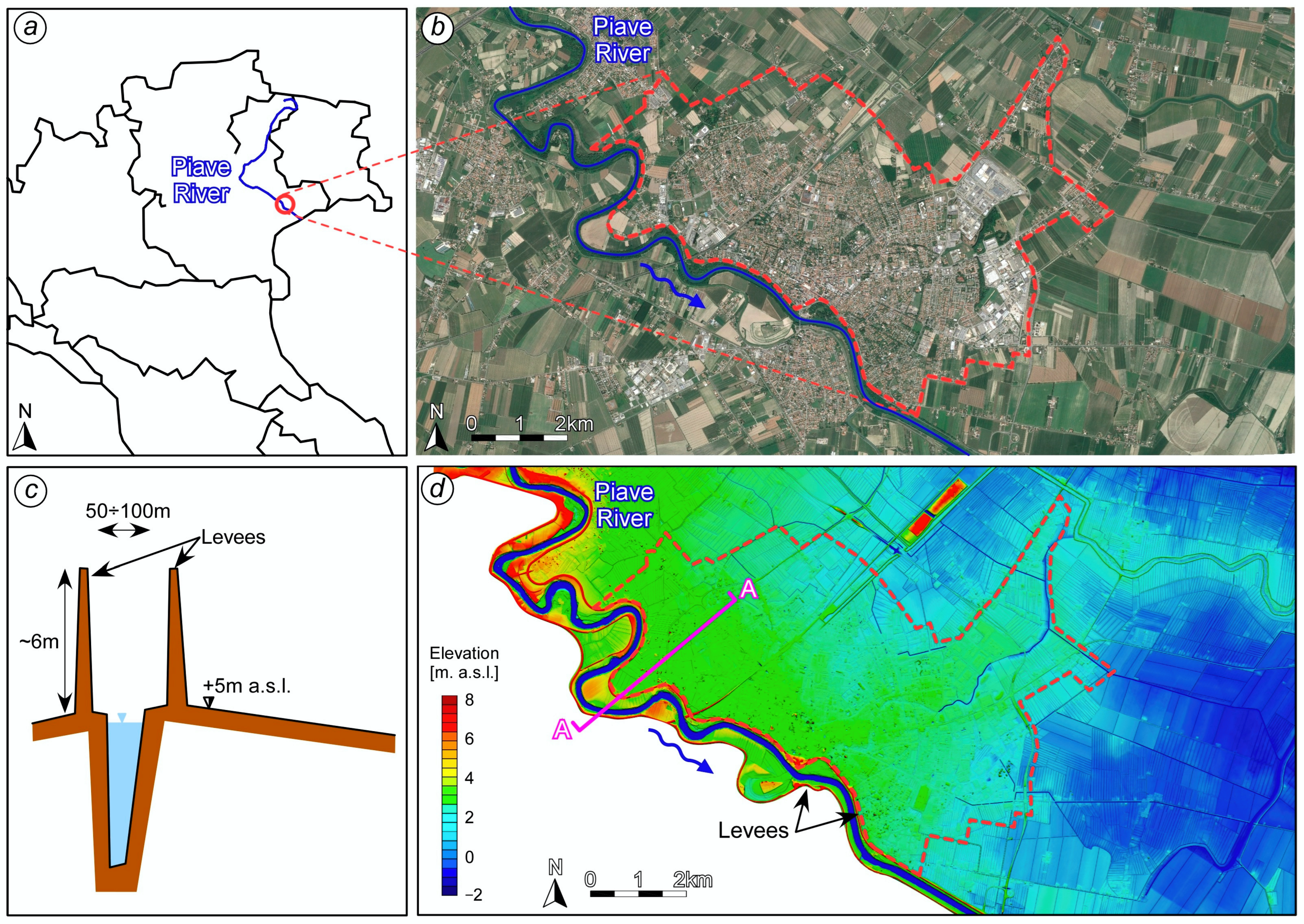
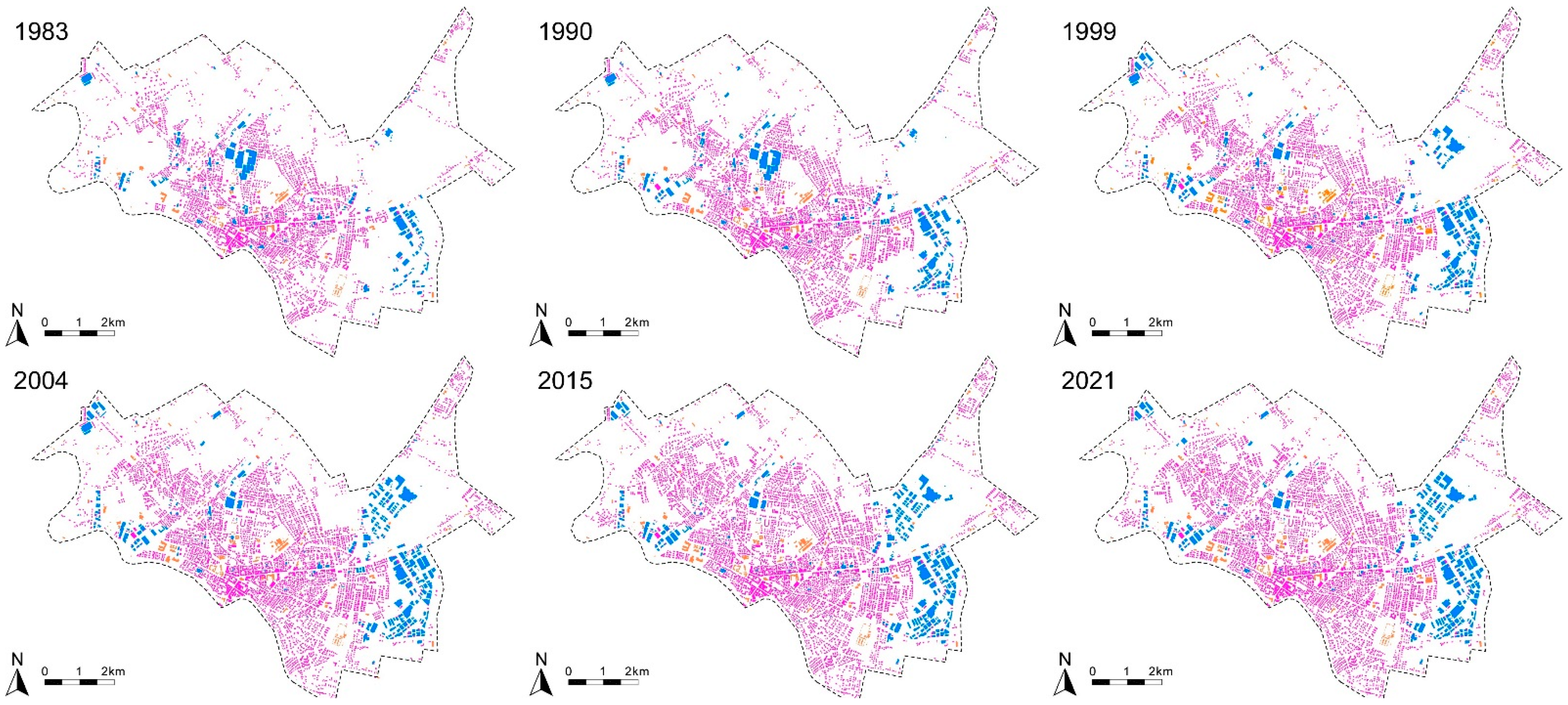
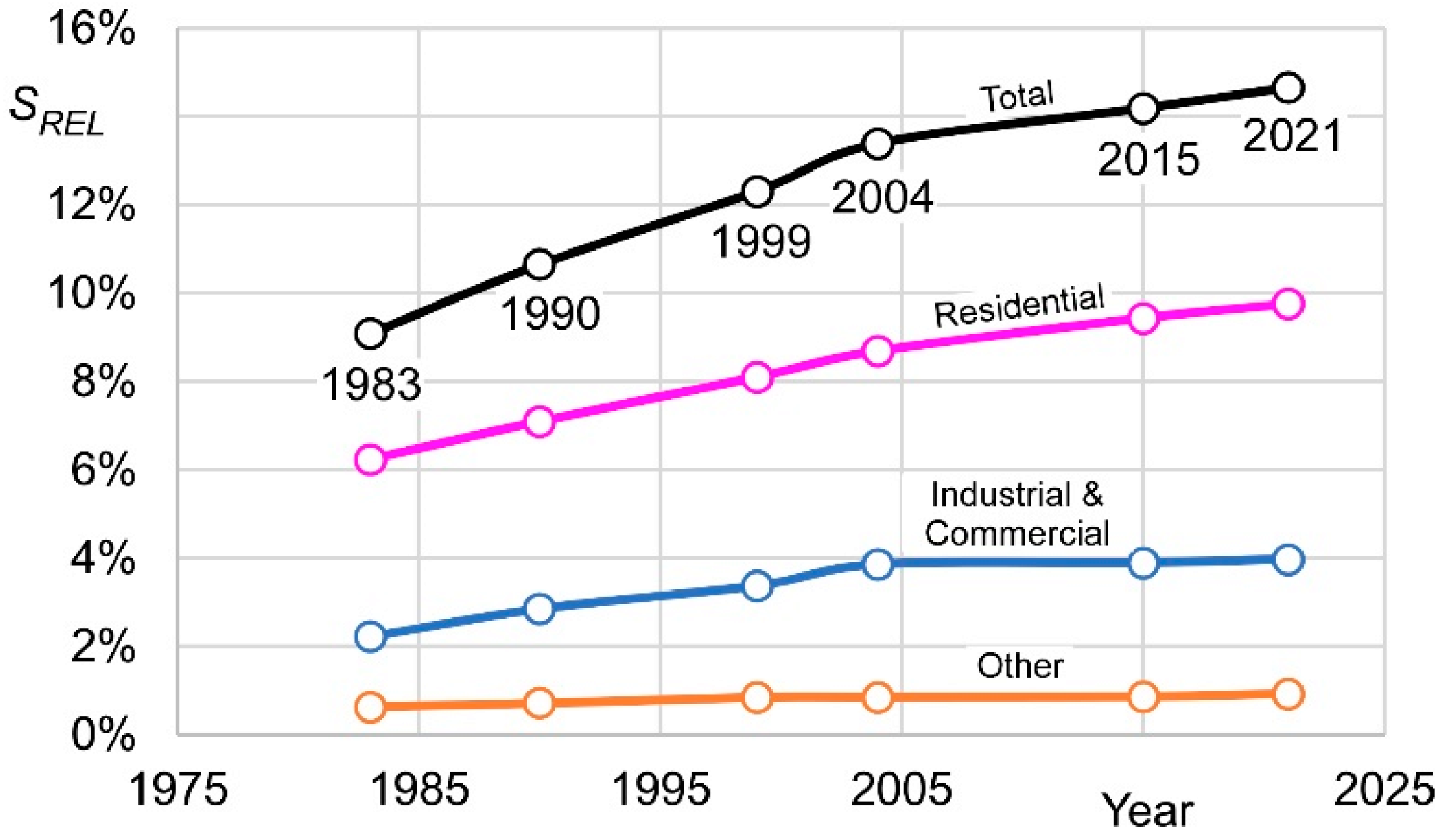
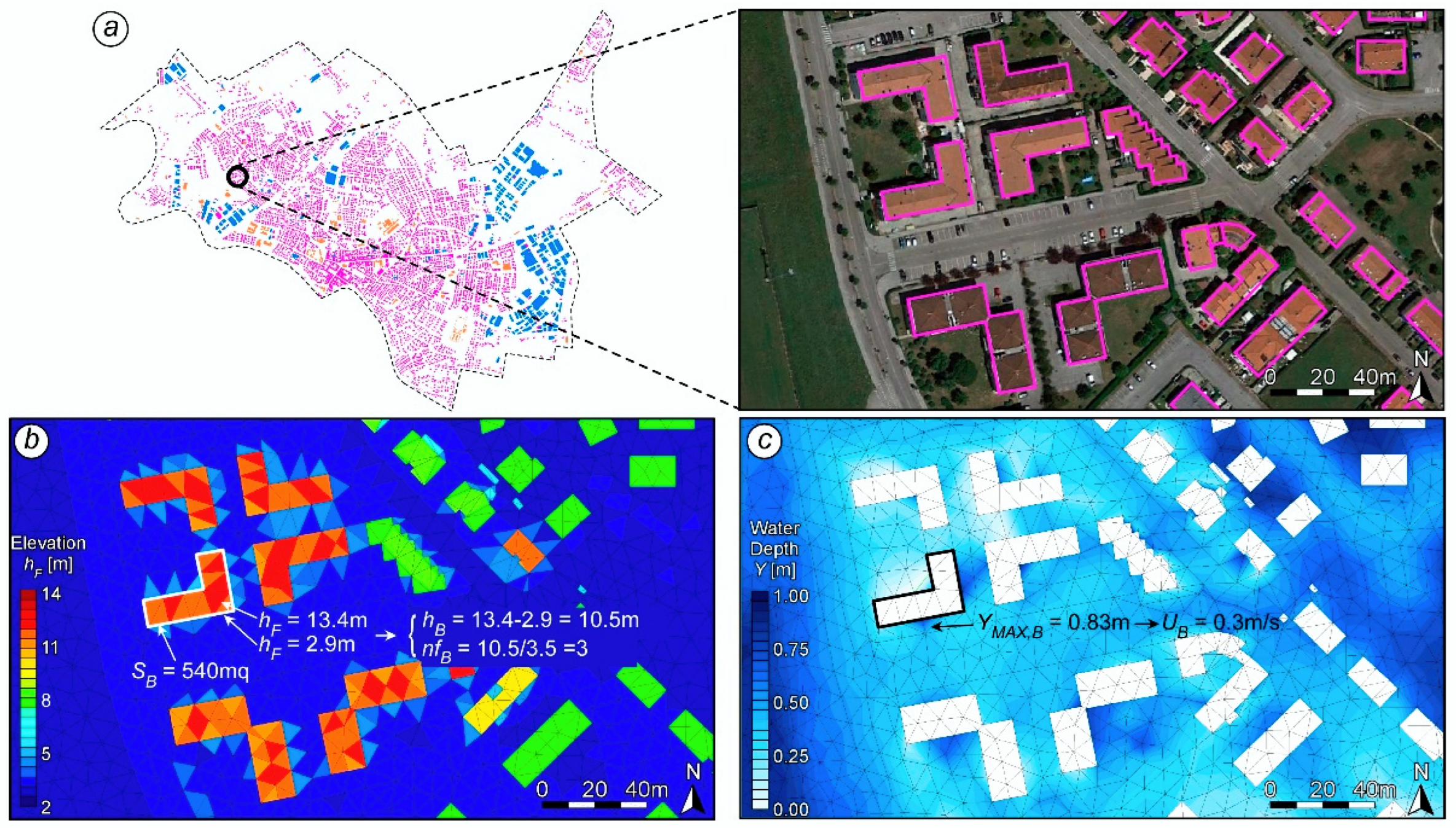

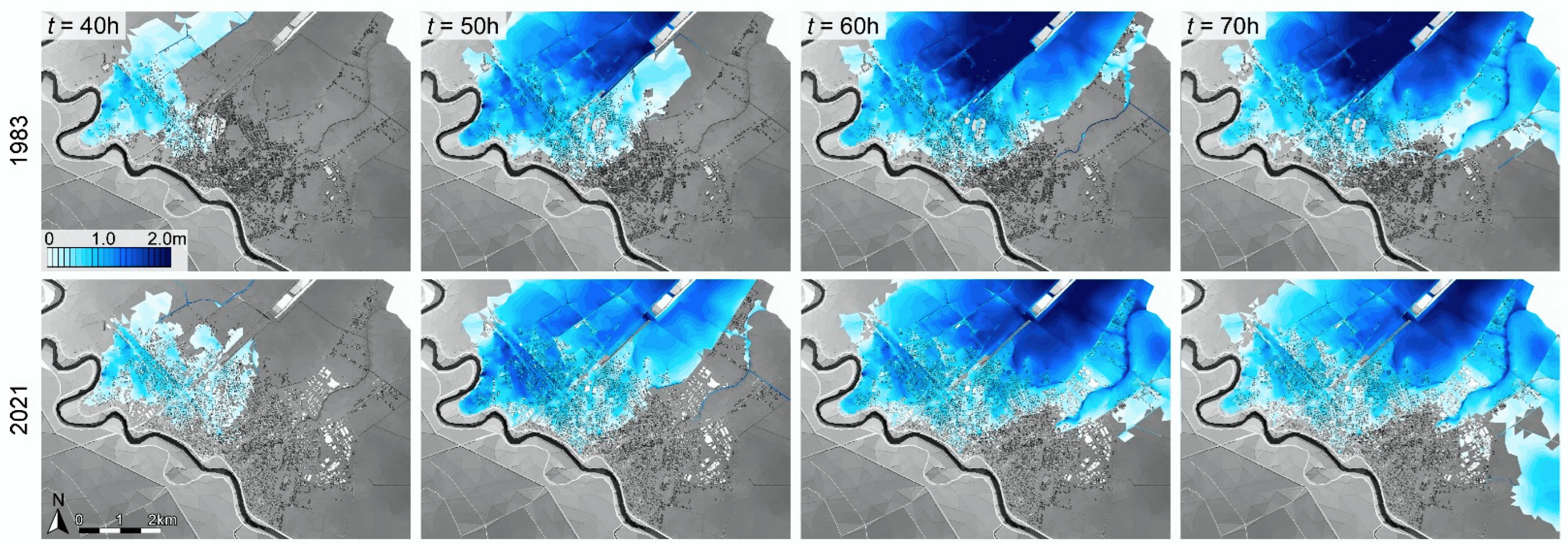
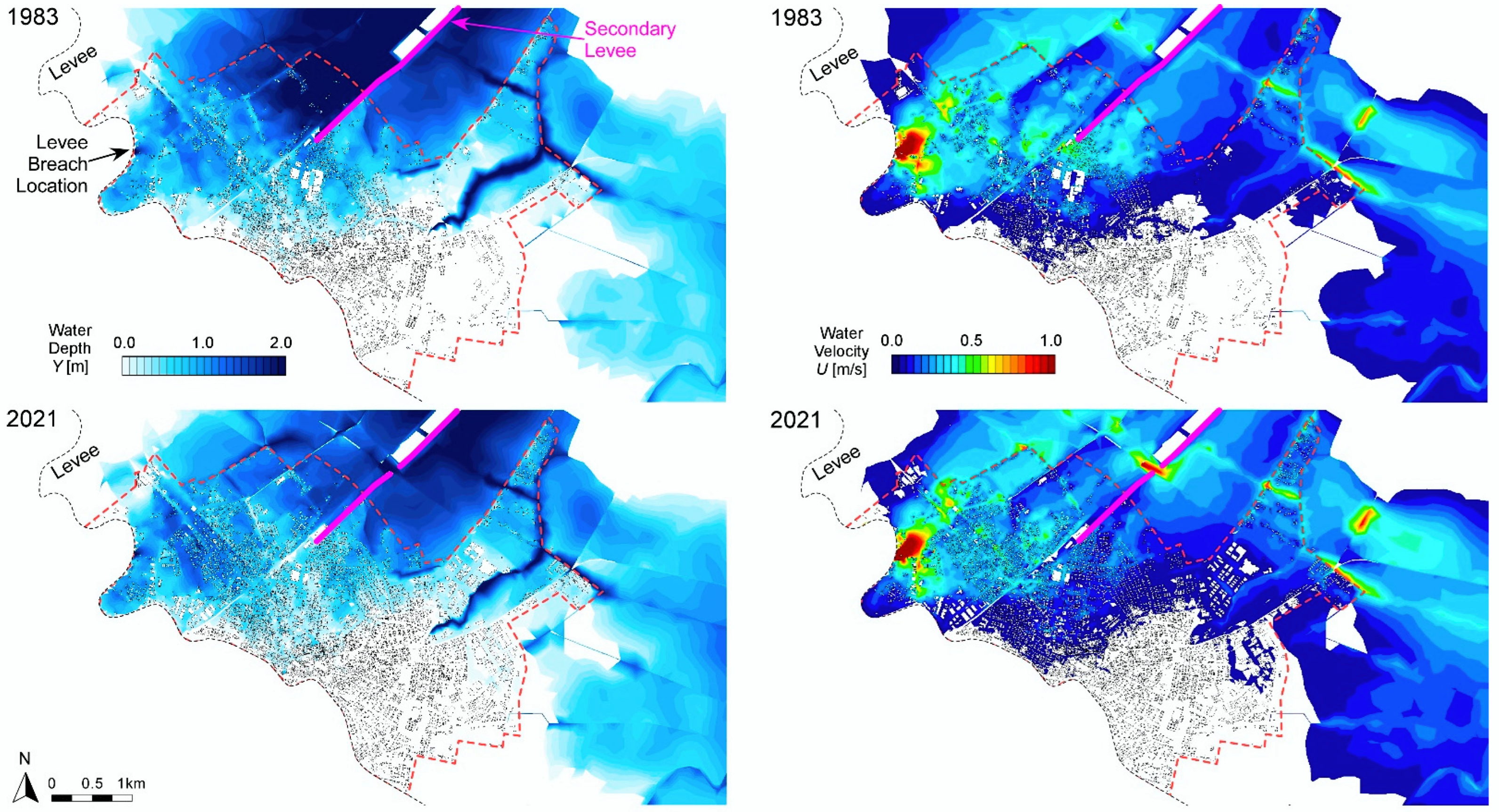
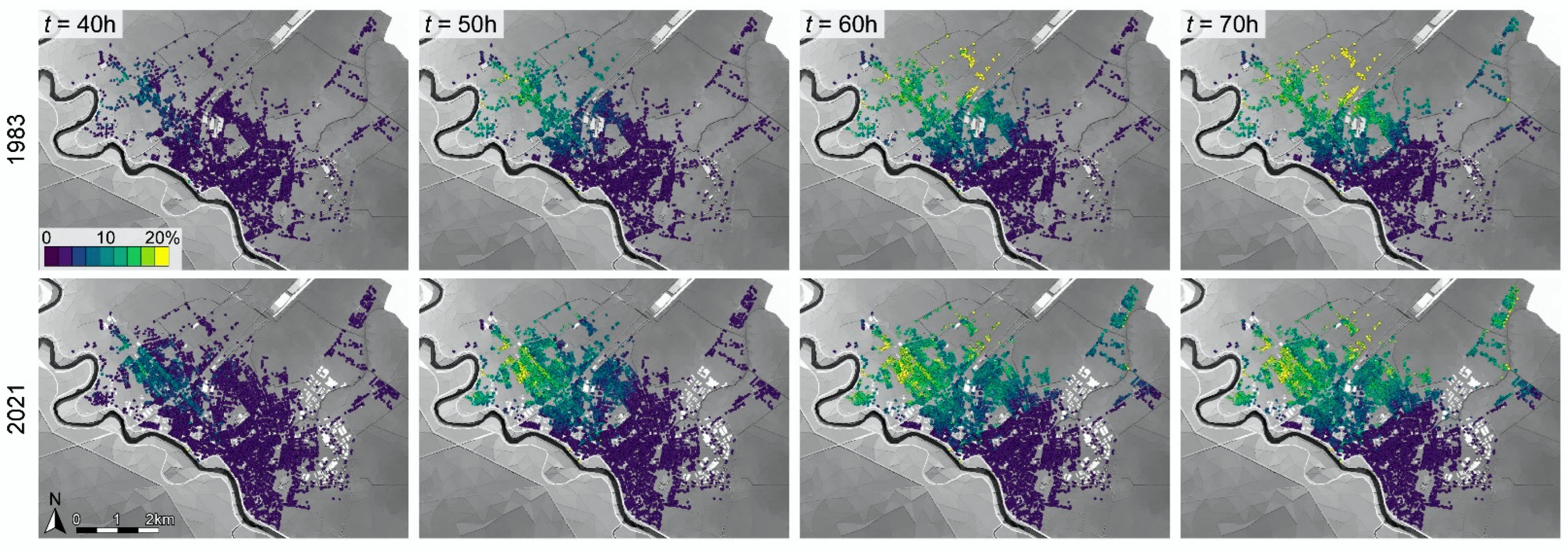

| Residential | Industrial and Commercial | Other | Total | |||||||||
|---|---|---|---|---|---|---|---|---|---|---|---|---|
| Year | S [m2] | SREL | % * | S [m2] | SREL | % * | S [m2] | SREL | % * | S [m2] | SREL | % * |
| 1983 | 937,000 | 0.0623 | 334,787 | 0.0223 | 94,935 | 0.0063 | 1,366,722 | 0.0909 | ||||
| 1990 | 1,066,044 | 0.0709 | +13.8% | 428,982 | 0.0285 | +28.1% | 107,051 | 0.0071 | +12.8% | 1,602,077 | 0.1065 | +17.2% |
| 1999 | 1,217,534 | 0.0809 | +29.9% | 507,225 | 0.0337 | +51.5% | 127,015 | 0.0084 | +33.8% | 1,851,774 | 0.1231 | +35.5% |
| 2004 | 1,306,676 | 0.0869 | +39.5% | 579,361 | 0.0385 | +73.1% | 128,265 | 0.0085 | +35.1% | 2,014,302 | 0.1339 | +47.4% |
| 2015 | 1,419,070 | 0.0943 | +51.4% | 585,436 | 0.0389 | +74.9% | 130,007 | 0.0086 | +36.9% | 2,134,513 | 0.1419 | +56.2% |
| 2021 | 1,467,209 | 0.0975 | +56.6% | 597,165 | 0.0397 | +78.4% | 139,976 | 0.0093 | +47.4% | 2,204,350 | 0.1466 | +61.3% |
| Year | n. of Buildings | Mean nfB | S⋅nfB [m2] | % * | D€,TOT [EUR] | % * | DREL,TOT | % * | nfB∙DREL,TOT | % * |
|---|---|---|---|---|---|---|---|---|---|---|
| 1983 | 5284 | 3.211 | 3,008,767 | 51,634,419 | 0.0172 | 0.0551 | ||||
| 1990 | 5901 | 3.193 | 3,404,318 | 13.1% | 59,939,236 | 16.1% | 0.0176 | 2.6% | 0.0562 | 2.0% |
| 1999 | 6610 | 3.192 | 3,886,348 | 29.2% | 77,139,893 | 49.4% | 0.0198 | 15.7% | 0.0634 | 15.0% |
| 2004 | 7142 | 3.173 | 4,145,500 | 37.8% | 77,869,616 | 50.8% | 0.0188 | 9.5% | 0.0596 | 8.1% |
| 2015 | 7461 | 3.152 | 4,472,644 | 48.7% | 88,575,568 | 71.5% | 0.0198 | 15.4% | 0.0624 | 13.3% |
| 2021 | 7569 | 3.143 | 4,610,819 | 53.2% | 95,775,646 | 85.5% | 0.0208 | 21.0% | 0.0653 | 18.5% |
Disclaimer/Publisher’s Note: The statements, opinions and data contained in all publications are solely those of the individual author(s) and contributor(s) and not of MDPI and/or the editor(s). MDPI and/or the editor(s) disclaim responsibility for any injury to people or property resulting from any ideas, methods, instructions or products referred to in the content. |
© 2023 by the authors. Licensee MDPI, Basel, Switzerland. This article is an open access article distributed under the terms and conditions of the Creative Commons Attribution (CC BY) license (https://creativecommons.org/licenses/by/4.0/).
Share and Cite
Lazzarin, T.; Defina, A.; Viero, D.P. Assessing 40 Years of Flood Risk Evolution at the Micro-Scale Using an Innovative Modeling Approach: The Effects of Urbanization and Land Planning. Geosciences 2023, 13, 112. https://doi.org/10.3390/geosciences13040112
Lazzarin T, Defina A, Viero DP. Assessing 40 Years of Flood Risk Evolution at the Micro-Scale Using an Innovative Modeling Approach: The Effects of Urbanization and Land Planning. Geosciences. 2023; 13(4):112. https://doi.org/10.3390/geosciences13040112
Chicago/Turabian StyleLazzarin, Tommaso, Andrea Defina, and Daniele Pietro Viero. 2023. "Assessing 40 Years of Flood Risk Evolution at the Micro-Scale Using an Innovative Modeling Approach: The Effects of Urbanization and Land Planning" Geosciences 13, no. 4: 112. https://doi.org/10.3390/geosciences13040112
APA StyleLazzarin, T., Defina, A., & Viero, D. P. (2023). Assessing 40 Years of Flood Risk Evolution at the Micro-Scale Using an Innovative Modeling Approach: The Effects of Urbanization and Land Planning. Geosciences, 13(4), 112. https://doi.org/10.3390/geosciences13040112







